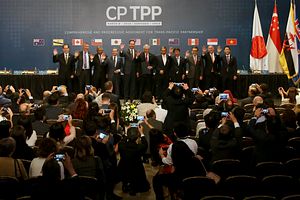“On the U.S. side, they are interested in a bilateral deal… Our country’s position is that the TPP is the best for both of our countries,” Japanese Prime Minister Shinzo Abe told reporters after the U.S.-Japan Summit on April 18 at Mar-a-Lago.
About a month ago, 11 Asia-Pacific countries signed the Comprehensive and Progressive Agreement for Trans-Pacific Partnership (CPTPP) in Santiago, Chile, on March 8, 2018. Formerly known as the TPP-11, the CPTPP is a multilateral free trade agreement (FTA) to lower non-tariff and tariff barriers between the member countries.
The original TPP agreement, the TPP-12, was planned to include 12 Asia-Pacific countries including Japan, Australia, Brunei, Canada, Chile, Malaysia, Mexico, New Zealand, Peru, Singapore, Vietnam, and the United States. However, in November 2016, with the electoral victory of U.S. President Donald Trump, an anti-TPP advocate, any hope of passing the TPP-12 vanished. Nevertheless, signing the TPP has been the main policy of Abe, and with Japan’s efforts as a leading country of TPP negotiations, the 11 remaining countries signed the CPTPP.
The CPTPP is one of the largest multilateral FTAs, dominating 13.5 percent of global GDP. Twenty-two provisions that the United States set as its priorities in the TPP have been modified or suspended in the CPTPP. The revisions include the investment and intellectual property (IP) chapters, thereby limiting investors’ ability to litigate disputes under investment agreements and authorizations. The length of medicine patent and copyright periods has been shortened as well. The revisions are a deviation from the American standard and show Japanese ambition to set a refreshed TPP deal without the United States.
While the CPTPP must be ratified by member countries to go into effect, it is clear that Japan will receive domestic and international gains from leading the CPTPP negotiations. Most of all, it is anticipated that the CPTPP will generate an additional $147 billion for the member countries, which in turn facilitates Japan’s economy growth and GDP. In addition, the agreement has institutionalized new trade rules for trade deals in the Asia-Pacific. For example, the framework of the CPTPP would likely become a model for other multilateral trade agreements, including the ASEAN-led Regional Comprehensive Economic Partnership (RCEP), strengthening Japan’s impacts on RCEP negotiations as a result. Therefore, the CPTPP helps Japan fortify and demonstrate its leading role in the Asia-Pacific, establishing a solid foothold in the global economy and diplomacy.
The CPTPP also helps Japan deal with U.S. pressure to negotiate a bilateral U.S.-Japan FTA. Since late 2017, President Trump has pushed Japan to sign a bilateral FTA which gives a clear trade advantage to the United States by enhancing its access to Japanese markets. The recent exclusion of Japan from the list of allies exempted from U.S. tariffs on steel and aluminum is also understood as American pressure on Japan – a case of gaiatsu, foreign pressure – to sign an FTA. This has made Japan feel vulnerable under the United States’ ability to weaponize its massive economic power. In this situation, by signing the CPTPP, Japan can argue that it will “not compromise beyond the deal it made in the CPTPP,” reducing U.S. gaiatsu. Former Japanese trade negotiator Kazuhito Yamashita even suggested that “if the U.S. demands a U.S.-Japan FTA, Japan should say that the U.S. should just join the CPTPP as Japan has switched to multilateral FTAs.”
Last but not least, the CPTPP helps Japan contain a rising China. Recently, Chinese President Xi Jinping signaled that China would become the new leader of free trade. The statement has triggered an extreme concern in Japan that the leadership vacuum in the Asia-Pacific free trade bloc created after the United States’ “America First” policy might be filled by the Chinese economy. In turn, the vacuum filled by China would threaten Japan’s future political and economic role in the Asia-Pacific. By setting the CPTPP, Japan can contain Chinese economic and trade expansion in the Asia-Pacific by utilizing the “strategic multilateralism” of the CPTPP. More specifically, medium-sized countries in the CPTPP can cooperate and increase their voices as even China finds it necessary to reflect their own interests in the economy of the Asia-Pacific.
The CPTPP, therefore, will be a cornerstone on which Japan can establish its economic and diplomatic power in the Asia-Pacific. Within the status quo, Japan is trying to improve its growth prospects. However, it would be impossible unless Japan attracts more foreign direct investment (FDI) to its market as well. With combined GDP of $10 trillion of the CPTPP members, Japan can attempt to double its FDI stock by 2020, which has been the goal of the Abe administration. It will ultimately lead Japan to bring in “new employment opportunities, foreign talents, and innovation.” Thus, for both its long-term domestic growth and international political clout, it would be critical for Japan to maintain its leading role in the CPTPP.
Eunseo Kim is a research intern at the Stimson Center’s Japan Program and an MA candidate in International Affairs at the Elliott School of International Affairs, The George Washington University.
































